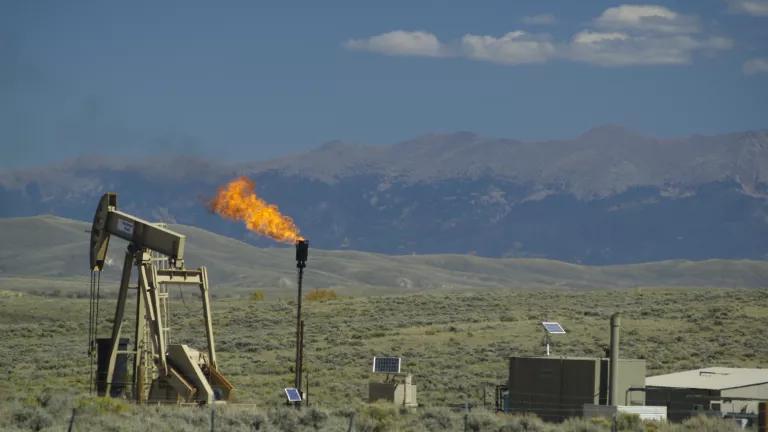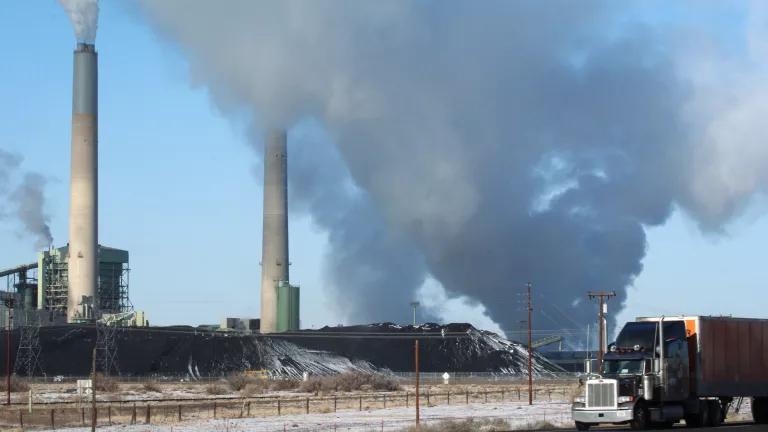Rule Will Cut Methane Waste from Federal Lands Drilling
The Bureau of Land Management published a final methane waste rule that will compliment EPA’s efforts to target a major contributor to climate change.

Colorado oil well flaring
The unnecessary flaring and venting of methane—the primary component in “natural gas”—on federal oil and gas leases wastes at least 152 billion cubic feet (bcf) of resources every year. That’s enough gas to produce 20.5 gigawatts of power, or enough energy to power more than 15 million homes per year. As astonishing as those numbers might be, a growing body of evidence also suggests they are vast underestimates of the actual waste occurring. Recent field studies have revealed just how necessary stricter and updated oversight has become. According to monitoring completed by the Environmental Defense Fund and CarbonTracker, operators in the Permian Basin are venting, flaring, and leaking methane at rates two-three times higher than they are reporting to the EPA.
That’s bad news for the climate, nearby communities, and U.S. taxpayers.
The preventable venting and leaking of methane and the unnecessary burning of methane via flaring lead to significant greenhouse gas emissions. Methane is an especially potent greenhouse gas with short-term warming potential 84 times greater than carbon dioxide. When it comes to cutting greenhouse gas emissions to limit global temperature increases, methane emissions need to be priority number one. With this rule, BLM is doing its part by using its authority to limit wasted resources and thereby prevent unnecessary release of methane into the atmosphere.
For nearby communities, unnecessary flaring from federal lands is also a serious health concern. According to data from 2019 compiled by the Environmental Defense Fund, at least 12,000 people live within half a mile from oil well flaring occurring on federal and Tribal lands. Shockingly, 25 percent of this population is Native American, and more than 20 percent of this population is made up of children under the age of five and adults over the age of 65.*(See note) For people living near oil and gas operations with consistent flaring, there are a range of increased health risks including asthma and other pulmonary diseases, heart disease, strokes, and even potential negative effects on fetal development.

Methane flaring at an oil and gas production site.
For U.S. taxpayers, all this waste also comes at a cost. Gas produced on federal leases is a public resource that oil and gas companies are technically required to pay for via royalties. However, until now, despite legal requirements that BLM prevent unnecessary waste, few efforts have been made to impose a cost or otherwise attempt to stop industry from simply burning up or venting this resource at will, with no consequences for the resulting pollution and harm to the climate. Thus, BLM’s estimates suggest that imposing royalties on unnecessary venting and flaring under its new rule will generate $51 million annually from federal and Tribal leases—a number that illustrates the money taxpayers have lost annually due to industry’s wasteful practices.
What does today’s final rule do specifically? In a nutshell, the rule has four overarching components:
- A general requirement for oil and gas companies “use all reasonable precautions” to prevent “waste of oil or gas” from federal leases. The rule also clarifies the BLM’s authority to impose future conditions as technology and industry practice evolves.
- A requirement that all new drilling permit applications contain a “waste minimization plan” (WMP) including all the steps a company will take to capture or otherwise reduce the waste of resources. The final rule substantially reduces the required content of WMPs and provides operators with the option of self-certifying their plans where they are willing to attest that 100 percent of gas produced during oil well drilling and production process will be captured and sold unless the gas is "unavoidably lost." Finally, the final rule reaffirms BLM’s authority to impose conditions on drilling permits to minimize waste or to even delay or deny the issuance of drilling permits where the agency determines that “waste minimization plans” are insufficient to prevent waste of publicly owned resources.
- Clarifications as to when gas can be deemed “unavoidably lost.” In other words, circumstances where companies can demonstrate that they’ve taken reasonable steps to avoid wasting gas but may be experiencing an emergency or other extenuating situations—as defined by the rule—that have led to flaring or venting.
- A variety of requirements oil and gas companies must take to further ensure minimization of wasted resources, through the development of a “leak detection and repair” program that allows for regular inspection of the entire suite of equipment being used at a production site and prompt maintenance, repair, or replacement of equipment where problems are discovered.
All of this is a welcome change. It has been more than 40 years since the government’s approach to venting and flaring has been updated, and more than 20 years since the Government Accountability Office (GAO) flagged concerns about unnecessary flaring and venting occurring on federal oil and gas leases. Of note is the BLM’s affirmation that, where oil and gas companies fail to demonstrate adequate measures for preventing waste, it may delay or deny permits to drill until a company can demonstrate that its operations will prevent unreasonable waste by stopping avoidable flaring or venting.
But there is at least one major hole in the BLM’s final rule: it has no enforceable requirement for operators on federal leases to capture most of the gas they produce from their leases or to prevent them from routine flaring that is especially concerning to frontline communities. Despite requiring permit applicants to submit WMPs to regulators, the rule does not require those plans to demonstrate that they can or will capture gas instead of venting or flaring it. Instead, the BLM is relying entirely on the obligation to pay royalties on wasted gas to incentivize a change in industry behavior. That’s a risky gamble and time will tell if it’s enough to drive down methane waste on federal oil and gas leases.
Even with the BLM choosing not to take advantage of its legal authority to do far more under a variety of laws including the Mineral Leasing Act, the Federal Oil and Gas Royalty Management Act, the Inflation Reduction Act, and the Federal Land Policy and Management Act, there may be hope that the hole BLM has left in its regulation will be filled. The EPA finalized its own methane emission regulations for the oil and gas industry in December 2023. Under those regulations, “new, reconstructed, and modified sources” will have to meet new, stricter standards. The EPA estimates the rule will reduce the industry’s methane emissions by more than 4 million short tons per year through 2038—an amount equivalent to an estimated 80 percent of methane emissions associated with oil and gas production in the U.S. Indeed, when EPA finalized its rule, it further closed regulatory gaps by imposing stricter limitations on flaring and clarifying its authority to regulate existing sources—a hole BLM initially flagged in EPA’s proposed approach.
Despite the relatively low costs these rules impose on industry—who have been enjoying multi-million dollar annual handouts by not paying anything for their completely unnecessary pollution—they are of course crying foul and running to their supporters on Capitol Hill for help. In the same breath, industry trade groups claim their members are all in on reducing emissions and being responsible players in the era of climate change. But opposition to baseline rules like this make clear that the oil and gas industry’s real goal is to operate as free from responsibility and regulation as possible. As the effects of climate change worsen by the day, this BLM rule is an important first step toward holding the oil and gas industry accountable.
* Note: This data was compiled by analysts at Environmental Defense Fund (EDF). EDF used Enverus data to identify wells with reported flaring in 2019 for Texas, New Mexico, Colorado, North Dakota, Montana, Wyoming, and Mississippi. EDF then used GIS spatial files from BLM (oil and gas leases), U.S. Forest Service (mineral rights), and Bureau of Indian Affairs (surface ownership) to extract just those wells on federal and Tribal lands. (As there is not a comprehensive database of tribal mineral ownership, surface ownership was used as a proxy for determining wells on tribal lands.) By identifying wells with flaring, we are also able to identify the local communities that are impacted by the air pollution from these wells. Using the methodology described in Proville, the demographic characteristics, U.S. Census Bureau’s American Community Survey 5-year estimates for 2015-2019, and health data from the Centers for Disease Control and Prevention’s Places dataset, we were able to estimate the populations living within a half mile radius of the previously identified wells using areal apportionment. See Centers for Disease Control and Prevention, PLACES: Local Data for Better Health, https://www.cdc.gov/places/index.html.




